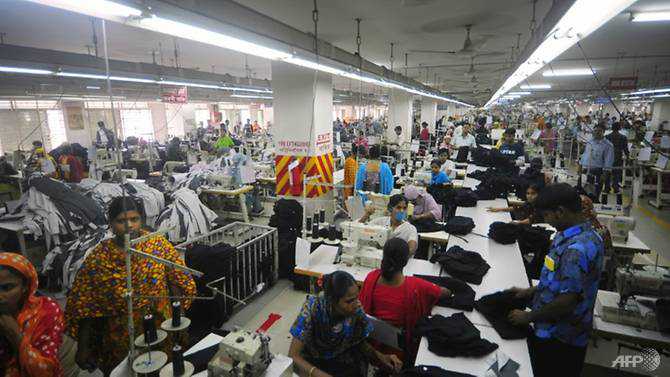Commentary: Is Bangladesh ready to graduate from least developed county status?
29 January, 2018

Bangladesh has more than 4,500 garment factories, many of which lack basic ventilation and air coolers, and which employ four million women workers at minimum monthly wages of $68 - AFP
Bangladesh looks prime to leave the United Nations’ least developed country category this year but policymakers should take heed of some signs of weakness in the economy, says the Centre for Policy Dialogue's executive director.
DHAKA: While Bangladesh’s macroeconomic indicators have shown positive trends in the last fiscal year, the overall strength of its economy appears to be weakening.
This is of particular concern as Bangladesh prepares to leave the United Nations' least developed country category in 2018.
One of Bangladesh’s major economic accomplishments was achieving a growth rate of 7.28 per cent over the 2016 fiscal year and thereby breaking the cycle of 6 per cent growth that has persisted for the last decade or so. Like in previous years, the major boost for growth came from the industrial and service sectors.
Another positive was that inflation remained steady at around 5.5 per cent - although food inflation increased towards the end of the year due to damage from flooding.
ROOM FOR IMPROVEMENT
Yet, other indicators show room for improvement. Bangladesh’s investment target was an increase to 32.7 per cent of GDP in fiscal year 2016. It fell just shy of this target, even though it increased to 30.5 per cent of GDP - a marginal increase from the 29 per cent recorded the fiscal year before.
More concerning is that the country’s private sector investment has been almost stagnant since 2016 at around 23 per cent of GDP.
The domestic savings-to-GDP ratio increased by a marginal 0.3 per cent over, while the national savings-to-GDP ratio declined by 1.2 percentage points to 20.6 per cent. This occurred against the backdrop of a large current account deficit.
The decline in the national savings-to-GDP ratio has in turn narrowed the gap between national savings and total investment as a share of GDP for the first time in recent years, which implies that more resources are being utilised.
Low export growth and negative remittance growth in recent times are concerning for Bangladesh’s economy. Export growth was 1.7 per cent, which is well below the target of 8 per cent. While both textile exports and total exports picked up in the later half of 2017, higher import growth led to a current account deficit of US$1.48 billion.
Remittances, the other major contributor to Bangladesh’s foreign exchange reserve, are showing fluctuations. In the last fiscal year, remittances experienced negative earnings growth of –15.9 per cent despite an increase in labour exports.
One important reason for this trend is the flow of remittances through informal channels, particularly through the Middle East, Singapore and Malaysia. The strength of the Bangladeshi taka against the US dollar also played a role in these fluctuations.
WEAKNESSES IN THE BANKING SECTOR
In 2017, the banking sector exposed further weaknesses: A rise in the volume of non-performing loans, a lower capital adequacy ratio and an overall lack of governance in the sector.
The implementation of Basel III — a voluntary regulatory framework aimed at strengthening regulation of the banking sector — is approaching in 2019, and most banks are not prepared.
For several consecutive years, the Bangladeshi government has recapitalised its state-owned banks for their losses - an unfortunate example of the government using public money to compensate for the greed of bank defaulters. New laws that allow for more members of the same family to be directors of privately-owned banks and for additional extensions of their tenures are likely to further deteriorate governance in private banks.
The government’s decision to issue licenses to new banks in a market that is already overcrowded with unhealthy banks does not bode well either. This decision is at odds with the central bank’s attempts to improve the performance of the banking sector.
The independence of the central bank has gradually diminished due to political influence. If the government does not undertake reform measures, a crisis in the banking sector will become increasingly likely in the coming years.
Another setback was the government’s inability to implement a value-added tax (VAT) in the face of pressure from the business community. The VAT law was set to be launched in the coming fiscal year, and the government’s backing out will deprive the country of valuable tax revenue.
2018 A TURNING POINT
2017 was a challenge for Bangladesh in terms of geopolitics. Members of Myanmar’s Rohingya minority have fled Rakhine State into Bangladesh in huge numbers since August 2017.
The humanitarian support currently provided by international organisations may not continue indefinitely. The burden will eventually fall to the Bangladeshi government, which will have serious budgetary implications.
2018 is set to be a turning point for Bangladesh. It is preparing to graduate from least developed country status in 2018 and will set its sights on becoming a middle-income country.
Achieving these goals will hinge on factors such as accelerating resource mobilisation, achieving higher investment, creating greater efficiency in infrastructure development, investing in skilled labour and strengthening institutions.
Bangladesh has placed significant emphasis on its GDP growth rate. As the country’s policymakers look beyond 2018, they should take greater heed of the quality and distributional aspects of such growth.
The incremental benefits from recent growth have accrued to the country’s rich rather than its poor. Higher income inequality is reflected in recent official data that reveal the top 10 per cent possess 38 per cent of Bangladesh’s total income while the bottom 10 per cent have only 1 per cent.
Broader development objectives - not narrow growth ones - need to be higher on the economic priority list in the coming years.
TAG(s):
